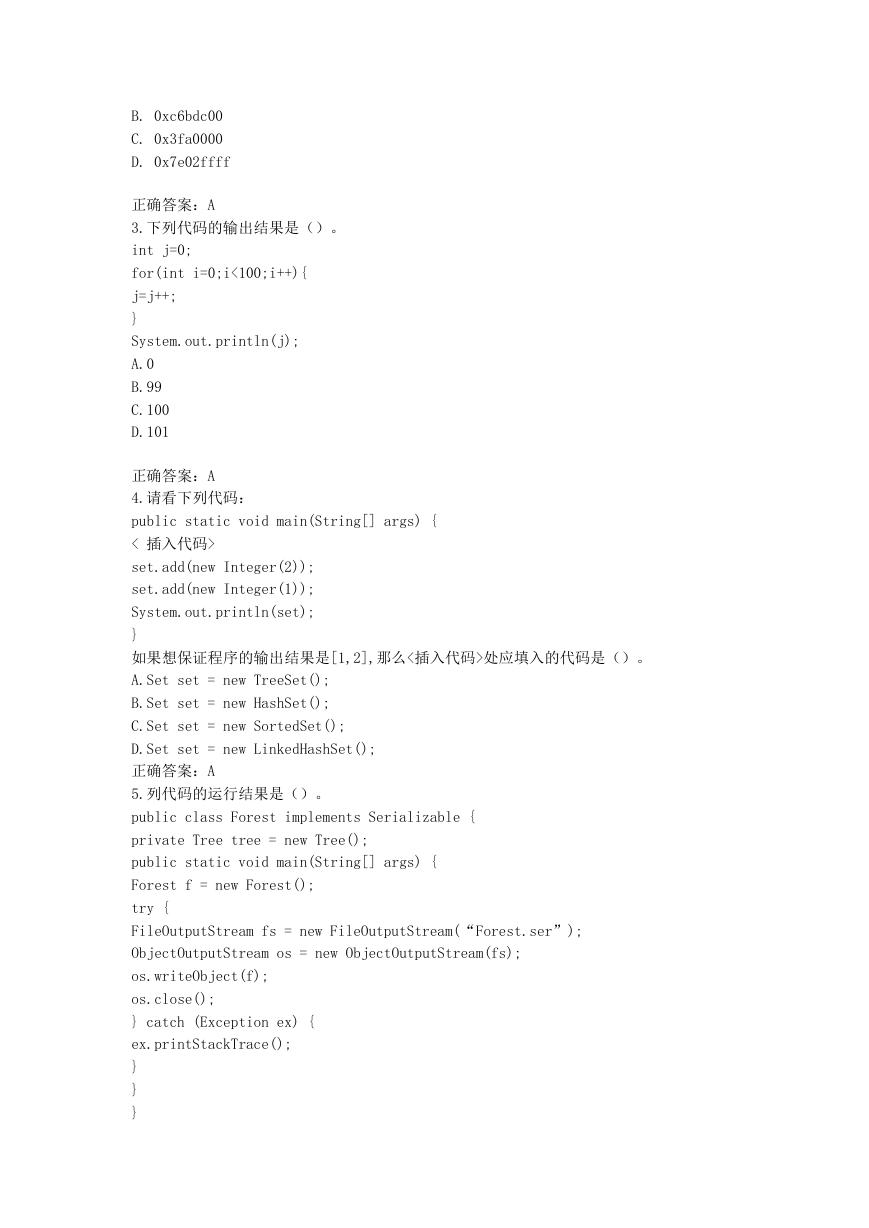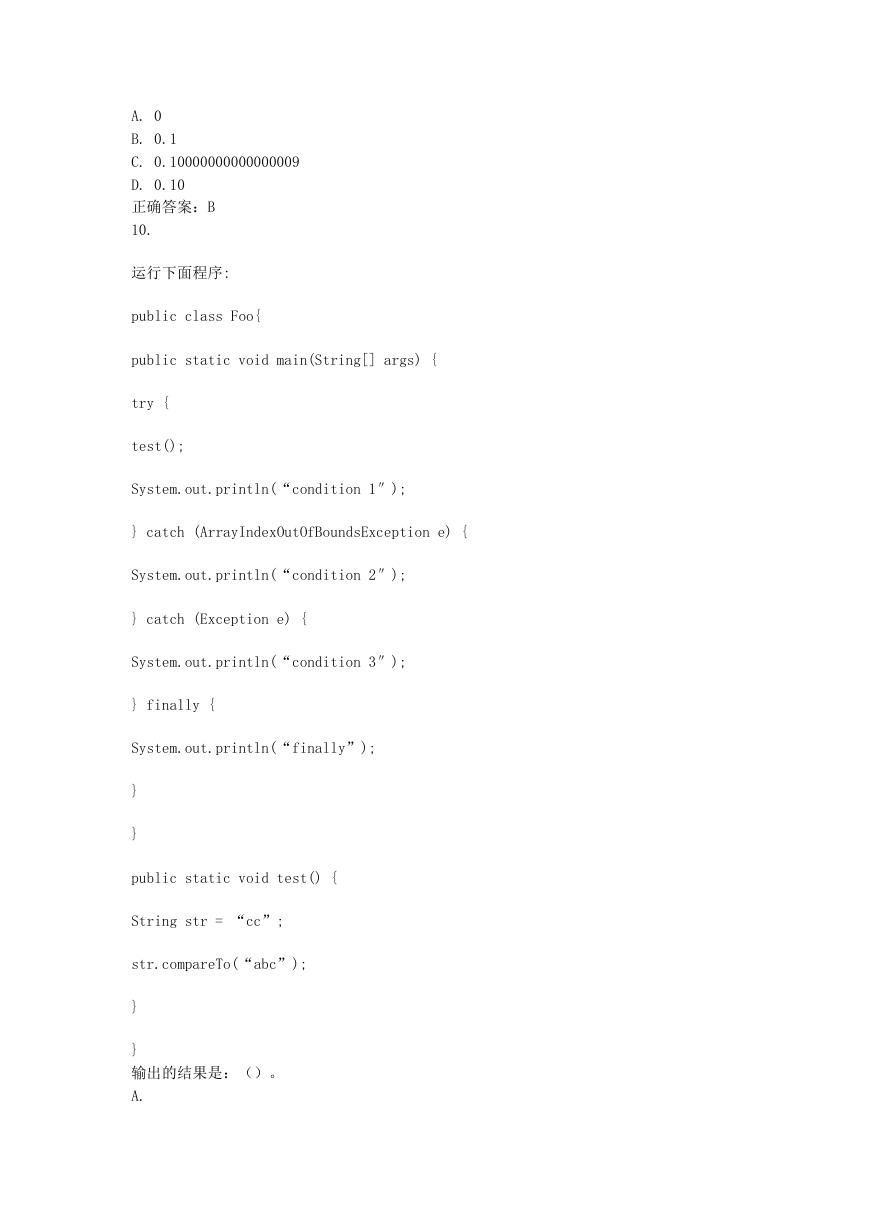中兴 Java 开发笔试试题及答案
1.类 A,B 和 C 的定义如下:
public class A {
public void f() {
System.out.println(“A.f()”);
}
}
public class B extends A {
public void f() {
System.out.println(“B.f()”);
}
}
public class C {
public void g(A a) {
System.out.println(“g(A a)”);
a.f();
}
public void g(B b) {
System.out.println(“g(B b)”);
b.f();
}
}
运行下面程序:
C c = new C();
A a = new B();
c.g(a);
输出的结果是:()。
A. g(A a)
A.f()
B. g(A a)
B.f()
C. g(B b)
A.f()
D. g(B b)
B.f()
正确答案:B
2.执行下列语句:
int a = 0x9af700; //1001 1010 1111 0111 0000 0000
a <<= 2;
变量 a 的值为:()。
A. 0x26bdc00
�
B. 0xc6bdc00
C. 0x3fa0000
D. 0x7e02ffff
正确答案:A
3.下列代码的输出结果是()。
int j=0;
for(int i=0;i<100;i++){
j=j++;
}
System.out.println(j);
A.0
B.99
C.100
D.101
正确答案:A
4.请看下列代码:
public static void main(String[] args) {
< 插入代码>
set.add(new Integer(2));
set.add(new Integer(1));
System.out.println(set);
}
如果想保证程序的输出结果是[1,2],那么<插入代码>处应填入的代码是()。
A.Set set = new TreeSet();
B.Set set = new HashSet();
C.Set set = new SortedSet();
D.Set set = new LinkedHashSet();
正确答案:A
5.列代码的运行结果是()。
public class Forest implements Serializable {
private Tree tree = new Tree();
public static void main(String[] args) {
Forest f = new Forest();
try {
FileOutputStream fs = new FileOutputStream(“Forest.ser”);
ObjectOutputStream os = new ObjectOutputStream(fs);
os.writeObject(f);
os.close();
} catch (Exception ex) {
ex.printStackTrace();
}
}
}
�
class Tree {}
A.编译失败
B.运行时,抛出异常
C.Forest 的实例被序列化到文件
D.Forest 的实例和 Tree 的实例都被序列化到文件
正确答案:B
6. 请看下列代码:
class Payload {
private int weight;
public Payload(int wt) {
weight = wt;
}
public Payload() {}
public void setWeight(int w) {
weight = w;
}
public String toString() {
return Integer.toString(weight);
}
}
public class TestPayload {
static void changePayload(Payload p) {
< 插入代码>
}
public static void main(String[] args) {
Payload p = new Payload();
p.setWeight(1024);
changePayload(p);
System.out.println(“The value of p is ” + p);
}
}
假设运行后输出“The value of p is 420”,那么<插入代码>处应填入代码是:
A. p.setWeight(420);
B. Payload.setWeight(420);
C. p = new Payload(420);
D. p = new Payload();
p.setWeight(420);
正确答案:A
7. 题目代码实现的功能是:把放入到 TreeSet 集合中的 Student 进行排序,首先按照 num
升序,如果 num 相同,再按照 name 降序。请问《插入代码 1》和《插入代码 2》处应填入的
代码分别是:
public class SortStudent {
public static void main(String[] args) {
�
TreeSet set=new TreeSet();
set.add(new Student(19,”tom”));
set.add(new Student(20,”jessica”));
set.add(new Student(19,”terry”));
}
}
class Student implements 《插入代码 1》{
private int num;
private String name;
public Student(int num,String name){
this.name=name;
this.num=num;
}
《插入代码 2》
}
A. Comparable
public int compareTo(Object o) {
Student stu=null;
if(o instanceof Student){
stu=(Student)o;
}
int result=this.num>stu.num?1:(this.num==stu.num?0:-1);
if(result==0){
result=this.name.compareTo(stu.name);
}
return result;
}
B. Comparable
public int compareTo(Object o) {
Student stu=null;
if(o instanceof Student){
stu=(Student)o;
}
int result=this.num>stu.num?1:(this.num==stu.num?0:-1);
if(result==0){
result=stu.name.compareTo(this.name);
}
return result;
}
C. Compartor
public int compare(Object o) {
Student stu=null;
if(o instanceof Student){
stu=(Student)o;
�
}
int result=this.num>stu.num?1:(this.num==stu.num?0:-1);
if(result==0){
result=this.name.compareTo(stu.name);
}
return result;
}
D. Compartor
public int compare(Object o) {
Student stu=null;
if(o instanceof Student){
stu=(Student)o;
}
int result=this.num>stu.num?1:(this.num==stu.num?0:-1);
if(result==0){
result=stu.name.compareTo(this.name);
}
return result;
}
正确答案:B
8.
下列语句创建对象的总个数是:()。
String s=”a”+”b”+”c”+”d”+”e”;
A.
1
B.
2
C.
3
D.
4
正确答案:A
9. 下列代码的输出结果是:
public static void main(String[] args) {
BigDecimal d1 = new BigDecimal(“3.0″);
BigDecimal d2 = new BigDecimal(“2.9″);
BigDecimal d3 = d1.subtract(d2);
System.out.println(d3);
}
�
A. 0
B. 0.1
C. 0.10000000000000009
D. 0.10
正确答案:B
10.
运行下面程序:
public class Foo{
public static void main(String[] args) {
try {
test();
System.out.println(“condition 1″);
} catch (ArrayIndexOutOfBoundsException e) {
System.out.println(“condition 2″);
} catch (Exception e) {
System.out.println(“condition 3″);
} finally {
System.out.println(“finally”);
}
}
public static void test() {
String str = “cc”;
str.compareTo(“abc”);
}
}
输出的结果是:()。
A.
�
condition 1
finally
B.
condition 2
finally
C.
condition 1
condition 3
finally
D.
condition 1
condition 2
finally
正确答案:A
11. 关于下列代码说法正确的是:
public class A {
private int counter = 0;
public static int getInstanceCount() {
return counter;
}
public A() {
counter++;
}
public static void main(String[] args) {
A a1 = new A();
A a2 = new A();
A a3 = new A();
System.out.println(A.getInstanceCount());
}
}
A. 该类编译失败
B. 输出:1
C. 输出:3
�
D. 输出:0
正确答案:A
12. 运行下列代码发生的异常或错误是:
public class ClassB {
public void count(int i) {
count(++i);
}
public static void main(String[] args) {
ClassB a = new ClassB();
a.count(3);
}
}
A. java.lang. StackOverflowError
B. java.lang.IllegalStateException
C. java.lang.ExceptionlnlnitializerError
D. java.lang.ArraylndexOutOfBoundsException
正确答案:A
13.
类 A,B 的定义如下:
class A {
private int a = 100;
A() {
System.out.print(“A()”);
System.out.println(a);
}
}
class B extends A {
private int a = 200;
B() {
System.out.print(“B()”);
System.out.println(a);
}
}
运行下面的代码:
new B();
输出的结果是:()。
A. A() 100
B() 200
B. A() 200
B() 200
�
















 2023年江西萍乡中考道德与法治真题及答案.doc
2023年江西萍乡中考道德与法治真题及答案.doc 2012年重庆南川中考生物真题及答案.doc
2012年重庆南川中考生物真题及答案.doc 2013年江西师范大学地理学综合及文艺理论基础考研真题.doc
2013年江西师范大学地理学综合及文艺理论基础考研真题.doc 2020年四川甘孜小升初语文真题及答案I卷.doc
2020年四川甘孜小升初语文真题及答案I卷.doc 2020年注册岩土工程师专业基础考试真题及答案.doc
2020年注册岩土工程师专业基础考试真题及答案.doc 2023-2024学年福建省厦门市九年级上学期数学月考试题及答案.doc
2023-2024学年福建省厦门市九年级上学期数学月考试题及答案.doc 2021-2022学年辽宁省沈阳市大东区九年级上学期语文期末试题及答案.doc
2021-2022学年辽宁省沈阳市大东区九年级上学期语文期末试题及答案.doc 2022-2023学年北京东城区初三第一学期物理期末试卷及答案.doc
2022-2023学年北京东城区初三第一学期物理期末试卷及答案.doc 2018上半年江西教师资格初中地理学科知识与教学能力真题及答案.doc
2018上半年江西教师资格初中地理学科知识与教学能力真题及答案.doc 2012年河北国家公务员申论考试真题及答案-省级.doc
2012年河北国家公务员申论考试真题及答案-省级.doc 2020-2021学年江苏省扬州市江都区邵樊片九年级上学期数学第一次质量检测试题及答案.doc
2020-2021学年江苏省扬州市江都区邵樊片九年级上学期数学第一次质量检测试题及答案.doc 2022下半年黑龙江教师资格证中学综合素质真题及答案.doc
2022下半年黑龙江教师资格证中学综合素质真题及答案.doc